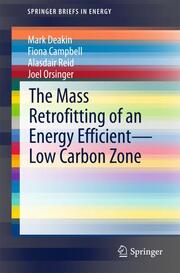Detailansicht
The Mass Retrofitting of an Energy EfficientLow Carbon Zone
SpringerBriefs in Energy
Deakin, Mark/Campbell, Fiona/Reid, Alasdair et al
ISBN/EAN: 9781447166207
Umbreit-Nr.: 7158608
Sprache:
Englisch
Umfang: vi, 110 S., 29 s/w Illustr., 38 farbige Illustr.,
Format in cm:
Einband:
kartoniertes Buch
Erschienen am 16.01.2015
Auflage: 1/2015
- Zusatztext
- Maximizing reader insights into the strategic value of mass retrofits in the residential property sector through a detailed case study analysis of the 'Hackbridge project', this book uses this development to broaden understanding of how planners may perform urban regeneration in accordance with a centralized plan.This book demonstrates how urban morphology matters, not only with respect to either the geometry of design and construction systems, or occupational behaviours, but with regards to the potential with which the planning, (re)development, design, construction, use and occupation of buildings, has to not only lower levels of energy consumption and rates of carbon emission, but also to reduce global warming associated with climate change.Delivering a critique of the state-of-the-art on urban morphology, the geometry of design typologies, construction systems and occupational behaviours and armed with the critical insights this offers, this book offers a context-specific analysis of how institutions can begin to actively plan for, integrate and sustain the development of energy efficient-low carbon zones.
- Kurztext
- Demonstrates how urban morphology matters in regards to lowering energy consumption and carbon emissions through the planning, (re)development, design, construction, use and occupation of buildingsCritiques the current state-of-the-art in urban morphology, the geometry of design typologies, construction systems and occupational behavioursUtilizes the case-study of the Hackbridge project in the London Borough of Sutton as an example of a mass retrofit proposal designed as a sustainable suburb with district centres, neighbourhoods and buildings, laid out and contextualised as an energy efficient-low carbon zoneIncludes supplementary material: sn.pub/extras
- Autorenportrait
- The authors are experts in environmental sustainability and have been involved in numerous research projects funded to reduce energy consumption and lower carbon emissions in line with legislation on climate change. The most recent research has been conducted while engaged on the UK funded EPSRC project on SURegen (Sustainable Urban Regeneration).
